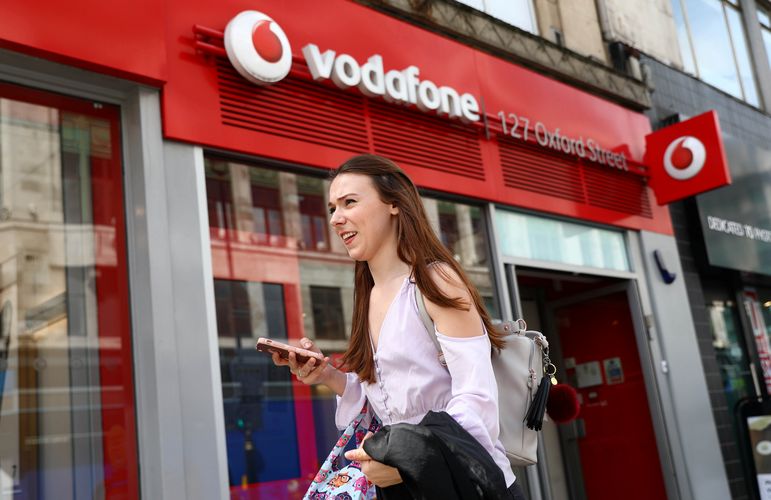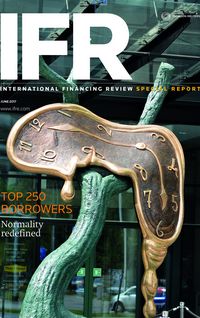The Top 250 borrowing period began and ended for Vodafone in the Swiss franc market, which was to prove crucial for its financing activities for the year. But while its forays into the Swiss franc market demonstrated its strategic thinking, the year was also characterised by a number of more opportunistic deals.
The Top 250 borrowing period began with one of Vodafone’s most significant trades, when it debuted in the Swiss bond market in May 2016. That market was to become an important component of its financing, with three deals in 12 months raising close to US$700m-equivalent.
The priority for its first deal was spread over size, which Vodafone saw as important in establishing a good starting data point in the new market, paving the way for the deals that would follow later. UBS was sole bookrunner on this first deal, sounding out the market on an 8.5-year at mid-swaps plus 62bp-67bp.
Books were eventually opened for a minimum SFr300m at mid-swaps plus 60bp-62bp, equating to a yield of 0.332%-0.352%. The deal was ultimately upsized to SFr350m, with the expected 0.375% coupon. A number of larger institutional investor orders ensured it priced at the wide end of guidance, at mid-swaps plus 62bp, in line with its euro curve on a currency-adjusted basis.
Its next visit to the market came in July, when it capitalised on the strong technicals prevailing at that time. In doing so, it was defying conventional wisdom that said issuers should avoid summer deals on the basis that investors will not be around to buy the paper. But accounts were particularly hungry for paper that summer, and when Vodafone came with a €1bn 15-year deal, it was rewarded with a strong investor response.
Despite a general demand for paper, Vodafone investors had some specific concerns around the possible implications of its M&A discussions with cable giant Liberty Global. With that in mind, Vodafone kept the change-of-control put option it had introduced in its last offering, a covenant that is triggered if more than 50% of the company is acquired, leading to a loss of its investment-grade credit rating.
That option certainly helped with the success of the deal. Initial price expectations had been mid-swaps plus 115bp area for a benchmark size, and leads set guidance at swaps plus 95bp–100bp. In excess of €3.9bn of orders came in for the paper, which priced at the tight end of guidance.
Bridging the BoE
The issuer had also been also looking at a 30-year tranche component to its euro deal, but found less interest for the longer dated tranche and ultimately dropped the idea. But, in August, it satisfied its desire for longer dated debt in sterling instead, a market renowned for favouring duration. Vodafone raised £800m in a 33-year benchmark trade, printing at 190bp over.
Then came the Bank of England’s summer announcement that it would be purchasing £10bn of corporate bonds, starting in September. Again, Vodafone was ready to move quickly with an opportunistic deal to take advantage of the favourable conditions in the market.
The BoE had also said it would cut rates by 25bp and increase its Gilt purchases by £60bn. But it was its intention to acquire the bonds of investment-grade companies that make a material contribution to the UK economy that caused the biggest stir, with sterling corporate bonds, especially at the long end, rallying hard. Among the beneficiaries was Vodafone’s recently printed 33-year deal, which tightened to 160bp over Gilts, 26bp inside where it was bid just ahead of the announcement.
Vodafone saw its opportunity to secure more long-term financing, printing 2016’s largest and longest corporate sterling issue, a £1bn 3% 40-year deal, having received orders for more than three times as much. That level of investor support allowed it to price tighter than the 170bp level given as guidance.
Vodafone’s penchant for duration was again in evidence only a few months later, when, in September, it was back in the Swiss franc market with a 15-year deal. This was the longest Triple B rated corporate public bond ever to print in that currency, coming in slightly larger than Enel’s SFr130m 15-year from 2013 that had been been based on a reverse enquiry.
It had been by no means certain that the Swiss investor base was ready for an issue of this rating and duration, especially with Single A rated Swisscom’s having issued a 16-year only two weeks previously. But after sounding the market out, Vodafone was emboldened to go ahead with the deal, initially setting a minimum SFr100m size, before later upping it to SFr150m. The bonds launched roughly 8bp inside Vodafone’s comparable euro-denominated paper, and significantly inside its US dollar and sterling curves.
It was back to the Swiss franc market again in March, with a 10-year deal that came in between 10bp and 20bp inside its euro curve, demonstrating the appeal of this market to issuers – while investors were also happy, given the bonds offered around 10bp over the franc curve. The deal started at SFr150m but was upsized to SFr175m, pricing at mid-swaps plus 53bp, capping a successful first 12 months in the Swiss market.
Between the two 2017 Swiss franc deals, Vodafone had come to market in February with an offering of US dollar Formosa bonds in Taiwan, one of a number of large corporate issuers looking to lock in flexible funding ahead of changes in local regulations and a potential shake-up in US tax rules. The Reg S bonds, with a 30-year non-call life structure, were listed in Taipei and issued off its EMTN programme, raising US$370m at a yield of 5.35%.
Around that time, Vodafone was also using an aggressive pricing strategy for a four-year euro benchmark deal, ultimately raising €1bn at 33bp over mid-swaps, again keeping its change-of-control put option in place.
To see the digital version of this special report, please click here
To purchase printed copies or a PDF of this report, please email gloria.balbastro@tr.com




